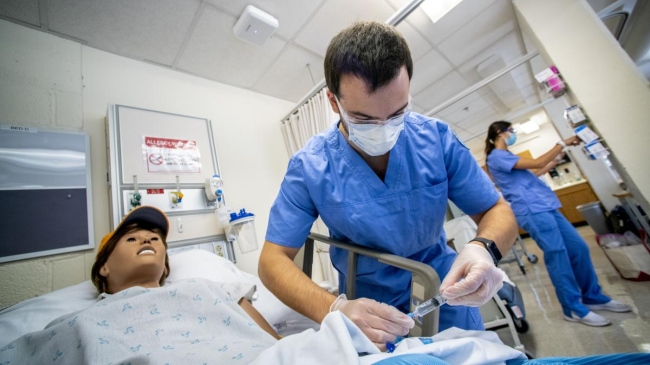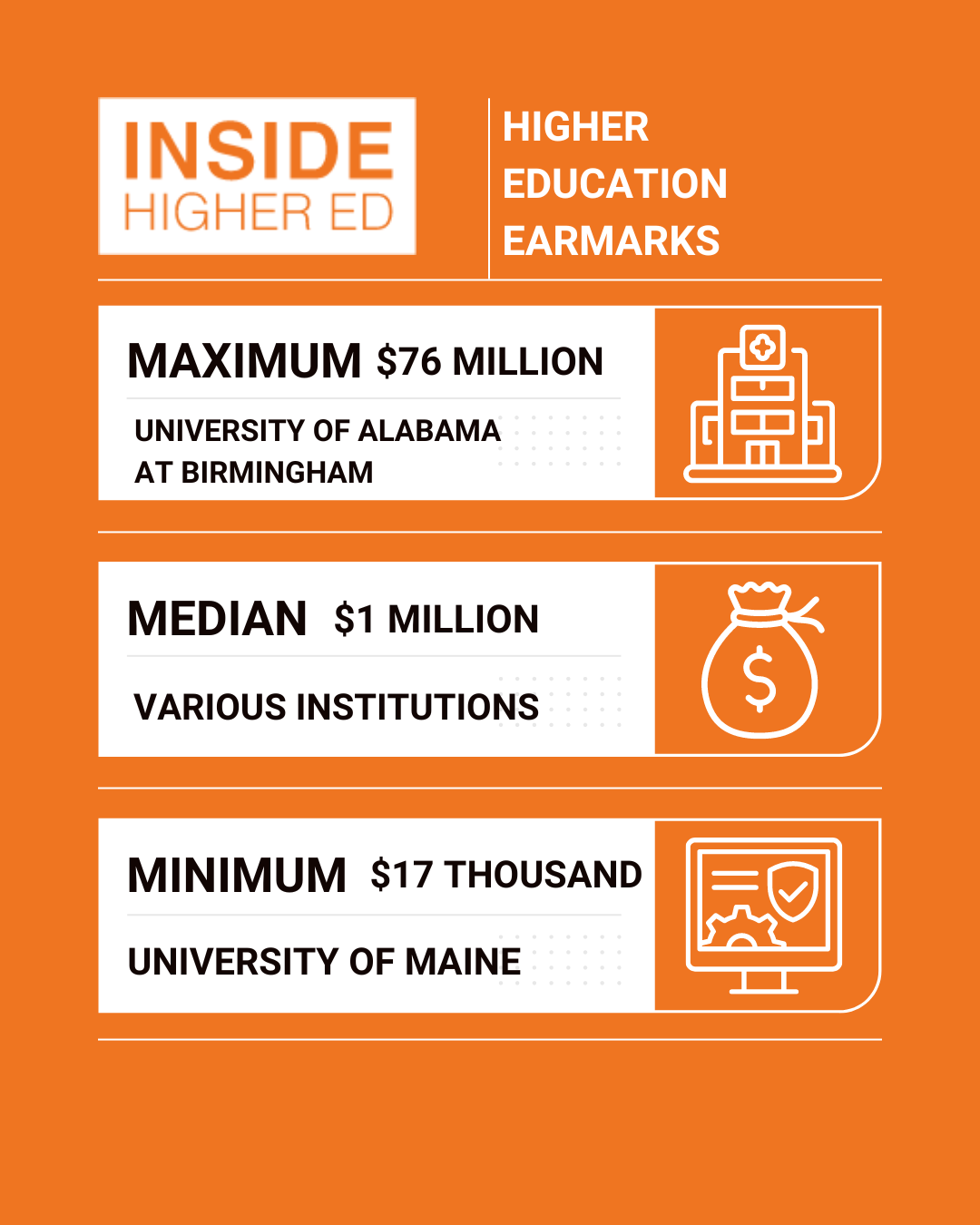You have /5 articles left.
Sign up for a free account or log in.

Dozens of higher education–related earmarks fund efforts to address the country’s nursing shortage.
University of Maine System
The University of Maine System is planning to use an infusion of federal funds to construct an advanced manufacturing research lab, start a new program in aviation maintenance, modernize a wild blueberry research facility and launch a statewide tick and tick-borne disease study.
The system and its affiliated campuses received nearly $53 million in earmarks for nearly two dozen projects as part of the fiscal year 2023 budget. Earmarks are doled out at the discretion of lawmakers and are not subject to a competitive peer-review process. The Association of American Universities has argued that earmarking of federal research funds has impaired the quality of federal research programs. The association declined to comment on the record about the recent batch of earmarks.
Higher education has been a top beneficiary of earmarks, which returned in 2021 after Democrats reversed a decade-long ban and made several reforms to the process. Earmarks, which have been renamed “congressionally directed spending” in the Senate and “community project funding” in the House of Representatives, send federal funds for specific projects to lawmakers’ districts and states.
“We needed a shot in the arm,” said Dannel Malloy, chancellor of the University of Maine System. “This is allowing that to happen.”
Of the more than 500 institutions that requested and received earmarks, the system had the most projects funded, which ranged from $17,000 to $8 million, according to an analysis of an Inside Higher Ed database of earmarks in the federal budget. The system’s use of earmarks is similar to how other institutions have used this process—to advance strategic goals, repair facilities and address challenges in their communities.
“We knew these earmarks were coming back, and I think we did the early work to be in front of it and to have a concise presentation of how the state could benefit from these investments,” Malloy said.
Joan Ferrini-Mundy, president of the University of Maine and the system’s vice chancellor for research and innovation, said projects funded are focused on researching the challenges Maine faces and helping to find solutions. The earmarks in the last two federal budgets have helped the university system be more responsive to problems in the state such as a shortage of nurses or the synthetic chemical compounds known as PFAS.
“It’s a pretty coherent portfolio,” she said. “Even though it looks like a wonderful and long list, but when you put everything together, it’s networks of knowledgeable people, ranging from people who fish for lobsters to researchers studying blueberries to the farmers who run the wild blueberry crop production in the state.”
Both Ferrini-Mundy and Malloy credited their representatives in Congress with helping to secure the earmarks. The state is represented by two senior senators, including Republican senator Susan Collins, who is now the ranking member on the appropriations committee.
Over all, 540 institutions, including community colleges, public and private colleges, and university hospitals and medical centers, received more than $1.73 billion in earmarks across more than 800 projects, according to the Inside Higher Ed analysis of the database. The database includes most of the higher education–related earmarks that were included in the 12 appropriations bills.
Republicans newly in control of the House of Representatives aren’t planning to do away with earmarks yet, but some lawmakers did criticize the practice during the drawn-out Speaker of the House election earlier this month.
“The current leadership that is in place will continue and support the use of earmarks in this body, and that is the golden trail to corruption,” Montana representative Matt Rosendale said on the House floor. “It is a way to buy votes and spread money around this body from places outside of this city. That leads to bad legislation and bad decisions.”
The nearly $1.7 trillion spending package that was the federal budget for fiscal year 2023 included $15 billion in earmarks for more than 7,200 projects, The New York Times reported. The last federal budget had $9 billion in earmarks for nearly 5,000 projects, not all of which involved higher education.
“Earmarks come and go,” said Terry Hartle, senior vice president for government relations and public affairs at the American Council on Education. “Historically, colleges and universities and medical centers and hospitals have been popular targets for earmarks.”
 The earmarks for individual projects ranged from $17,000 to the University of Maine System for technology equipment at its public service legal aid clinic up to $76 million for the University of Alabama at Birmingham’s Heersink School of Medicine, according to the analysis.
The earmarks for individual projects ranged from $17,000 to the University of Maine System for technology equipment at its public service legal aid clinic up to $76 million for the University of Alabama at Birmingham’s Heersink School of Medicine, according to the analysis.
The average amount awarded for projects was $2.15 million. The median project was awarded $1 million. Funding for individual institutions ranged from $100,000 to $113 million. The average was $3.2 million, while the median institution received $1.25 million.
In the recent budget, universities in states represented by powerful retiring senators came out on top. Former Alabama senator Richard Shelby, a Republican, sent more than $206 million to Alabama colleges and universities—$171 million of which went to the University of Alabama system.
The University of Alabama at Tuscaloosa received a total of $95 million, including $50 million for an endowment fund to support the recruitment and retention of science and engineering faculty. Shelby also sent the $76 million to the University of Alabama at Birmingham for the construction of a new biomedical research building. He earlier secured another $76 million for the project in the fiscal year 2022 budget.
“That’s exceptionally rare, because it is one medical school in one state that has a retiring senator who chairs the appropriations committee,” Hartle said. “That just doesn’t happen very often. It’s more likely going to be a grant of $500,000 or one million dollars that will go to an individual school for a specific program.”
Former Missouri senator Roy Blunt, a Republican, secured more than $186 million for Missouri colleges and universities, including $131 million for the University of Missouri system. That includes $61 million for construction and equipment at the Roy Blunt NextGen Precision Health Institute and $20 million for design and planning of a research reactor, among other projects.
“Thanks to this federal funding support, we will be able to continue and accelerate the critical work underway at our institutions,” Missouri system president Mun Choi said in a statement. “We remain grateful for the work of our congressional delegation, especially former Senator Blunt and Representative [Blaine] Luetkemeyer for their tireless advocacy.”
Many of the earmarks funded specific programs and equipment purchases. For example, Malcolm X College, part of the City Colleges of Chicago, is planning to use $1 million for an emergency medical technician student success program, which includes equipment. Other earmarks are going toward research, from purchasing equipment to building labs. Portland State University, for one, is receiving $785,000 to establish the Oregon Microplastics Research Center.
Hartle said the money for earmarks is a “drop in the bucket” in terms of overall federal funding for higher education and student aid.
“But if you are an institution that has received an earmark, it is going to be enough money for you to launch or be in something that you could not otherwise do,” he said. “The money itself can be transformational for individual schools.”
For example, he pointed to the $915,000 allocation for Columbia International University in South Carolina to support a new nursing education program, which includes purchasing equipment. The university received state approval last year to start a bachelor of science in nursing program for the 2022–23 academic year.
“Many of the things in higher education that earmarks are used for are things that can’t be funded under other existing federal programs,” Hartle said. “If there are programs along those lines, they tend to be very oversubscribed.”
Nearly two dozen other funded projects, including one at the University of Maine System, support nursing education projects.
“More people want to be nurses than can be accommodated at the present time, so this is going to have a huge impact in that community in terms of creating nurses who will feed directly into the health-care system,” Hartle said.




